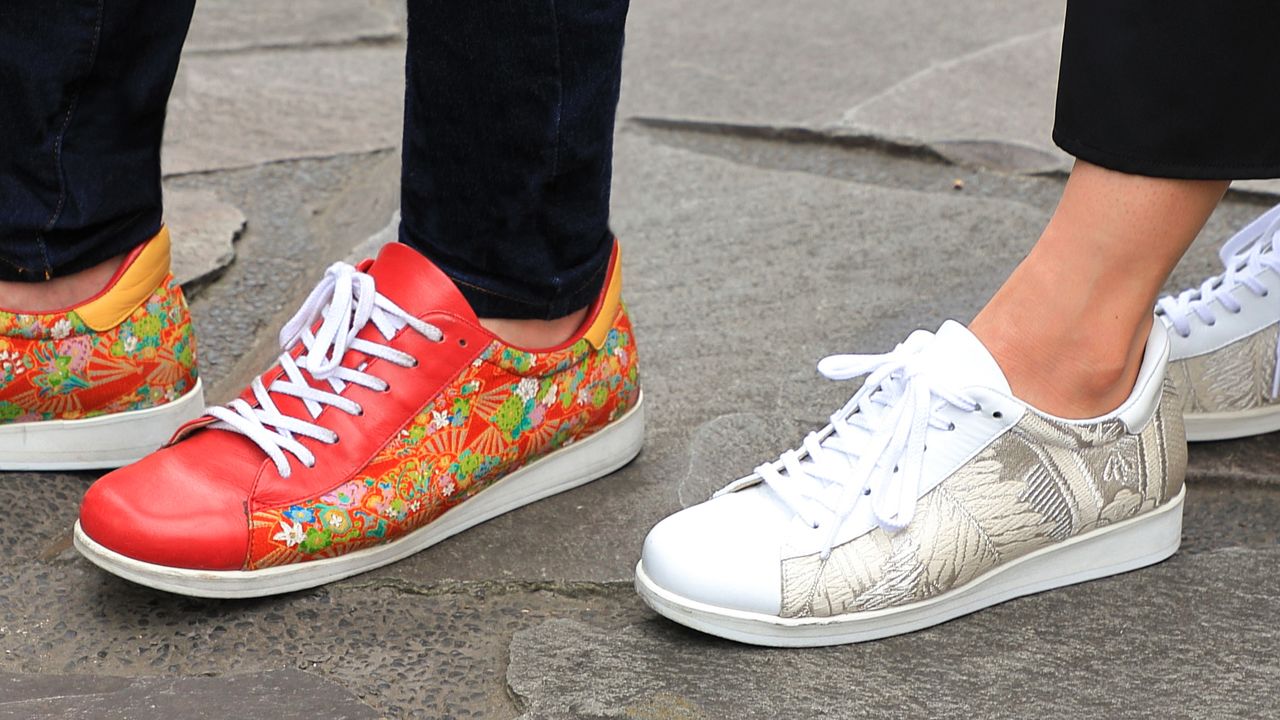
From Fine Robes to Footwear: Sneakers Made with Recycled Kimono Fabric
Guideto Japan
Fashion Culture Environment- English
- 日本語
- 简体字
- 繁體字
- Français
- Español
- العربية
- Русский
“Kimono Shoes“ Gain Popularity Overseas
Genuine leather sneakers that incorporate upcycled kimono fabric rescued from storage are growing popular throughout Japan and in other markets around the world. Sneakers of this type have been sold under the brand Tokyo Kimono Shoes online from 2021. In January 2023 a brick-and-mortar shop popular with tourists opened in Tokyo’s Asakusa district. Building on the post-COVID-19 consumption rebound, sales of the shoes have increased fourfold compared to when they were only available online. As of August 2023, there is a wait of approximately two months from order to delivery.
“These sneakers are one-of-a-kind items that are crafted by artisans,“ says Kawamura Shōtarō, president of Potato Co., which produces the brand. “As a result, production can’t keep up with the pace of orders,” he adds with obvious satisfaction.
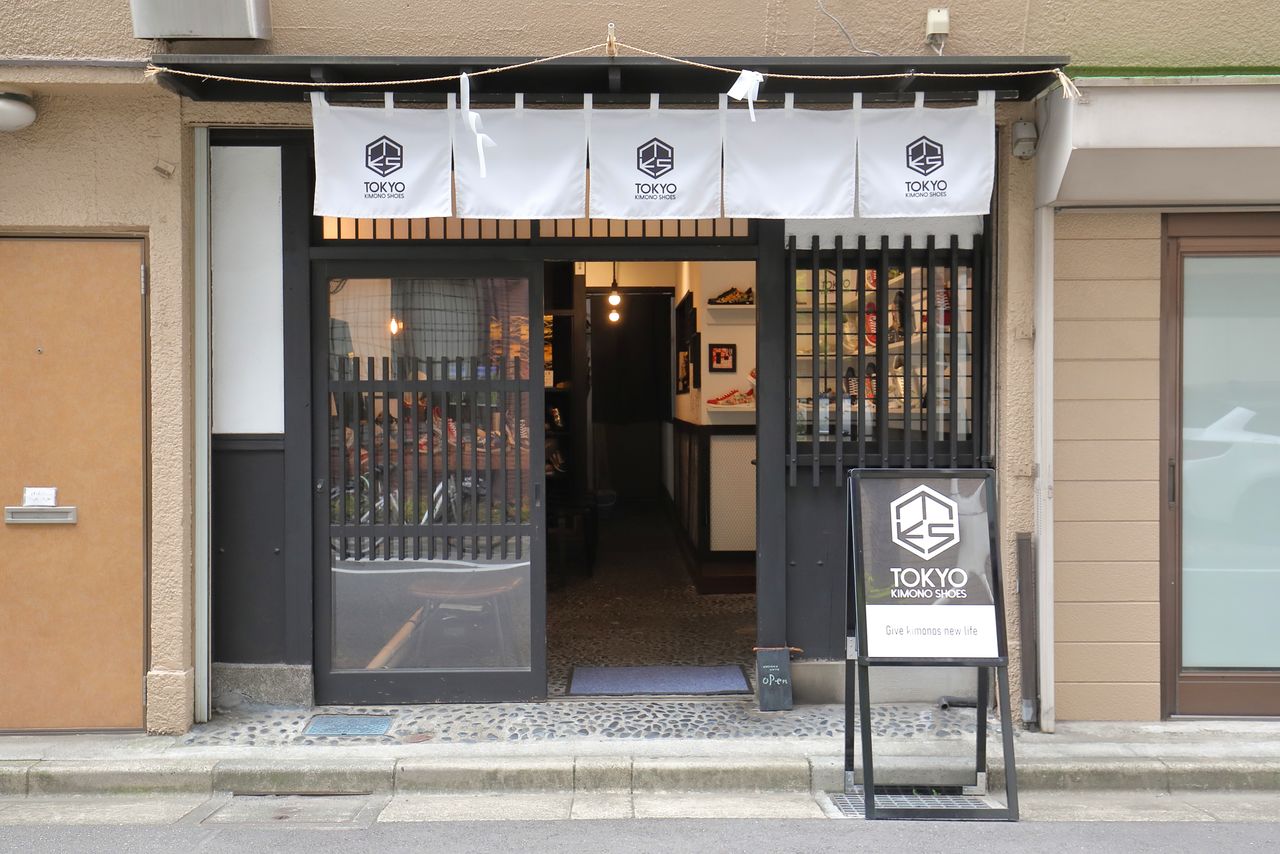
The storefront recalls early twentieth-century Asakusa. (© Hanai Tomoko)
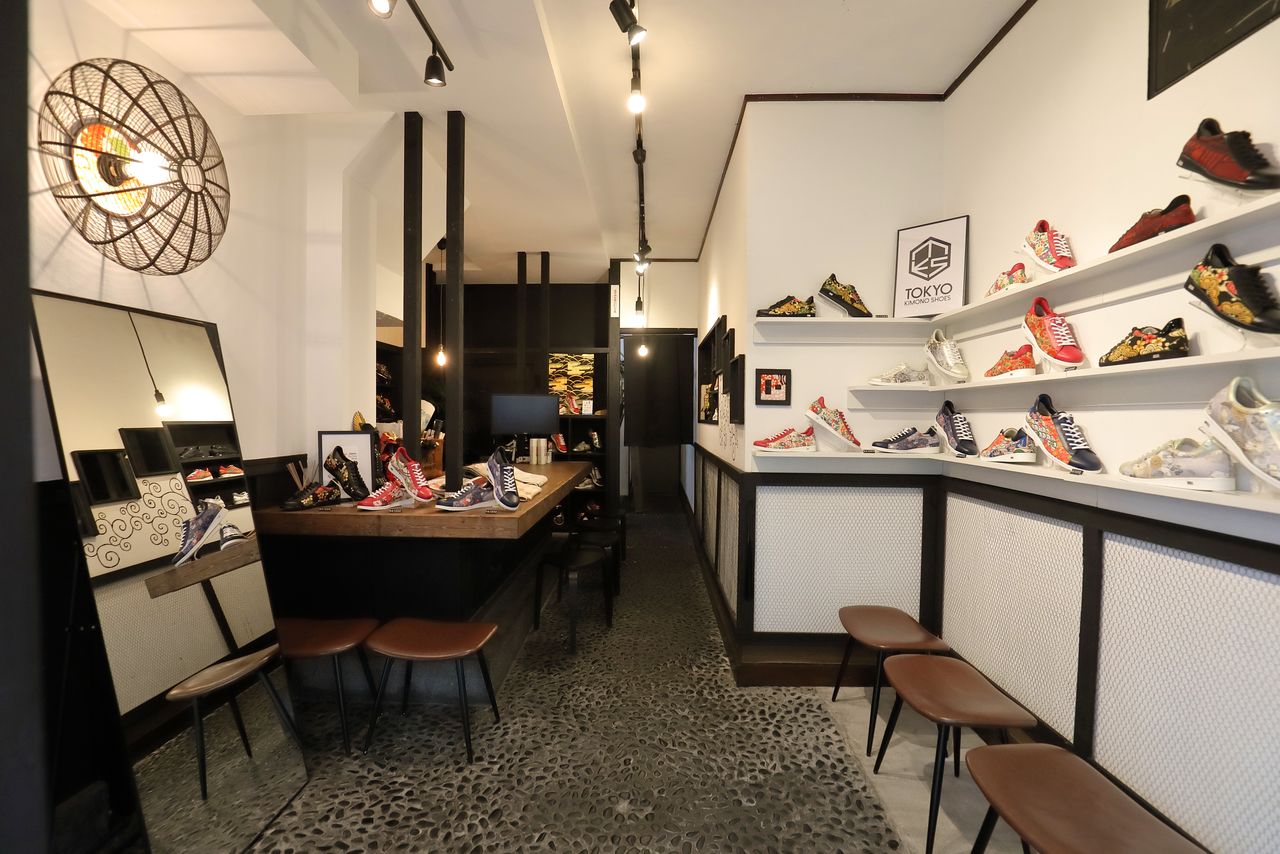
Each pair of shoes is unique. (© Hanai Tomoko)
Although the shop gets at most about 30 customers per day, the purchase rate is extremely high. This is at least partially due to the fact that the shop is located away from the busy Asakusa downtown area, which means that very few people who make their way to the store are casual window-shoppers. Most customers come to try on and purchase items they found online, or to pick up custom-made orders.
Around four in five customers are non-Japanese. Some 40% of these foreign shoppers are from the United States, with approximately 20% each hailing from Europe, Oceania, and Southeast Asia, respectively. According to an analysis conducted by Kawamura, many customers arrive from English-speaking countries thanks to the company’s advertising campaigns on social networking sites with worldwide reach.
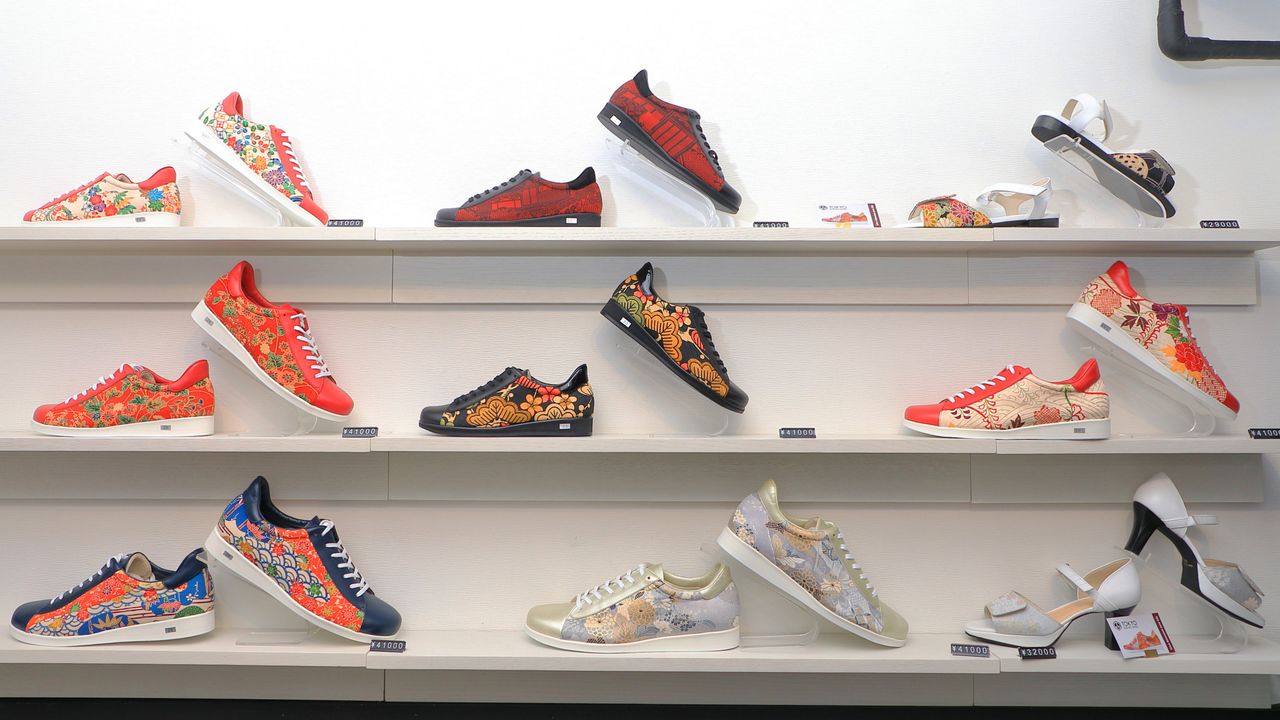
One of their many charms is the fact that the right and left shoes of each pair do not match exactly. (© Hanai Tomoko)
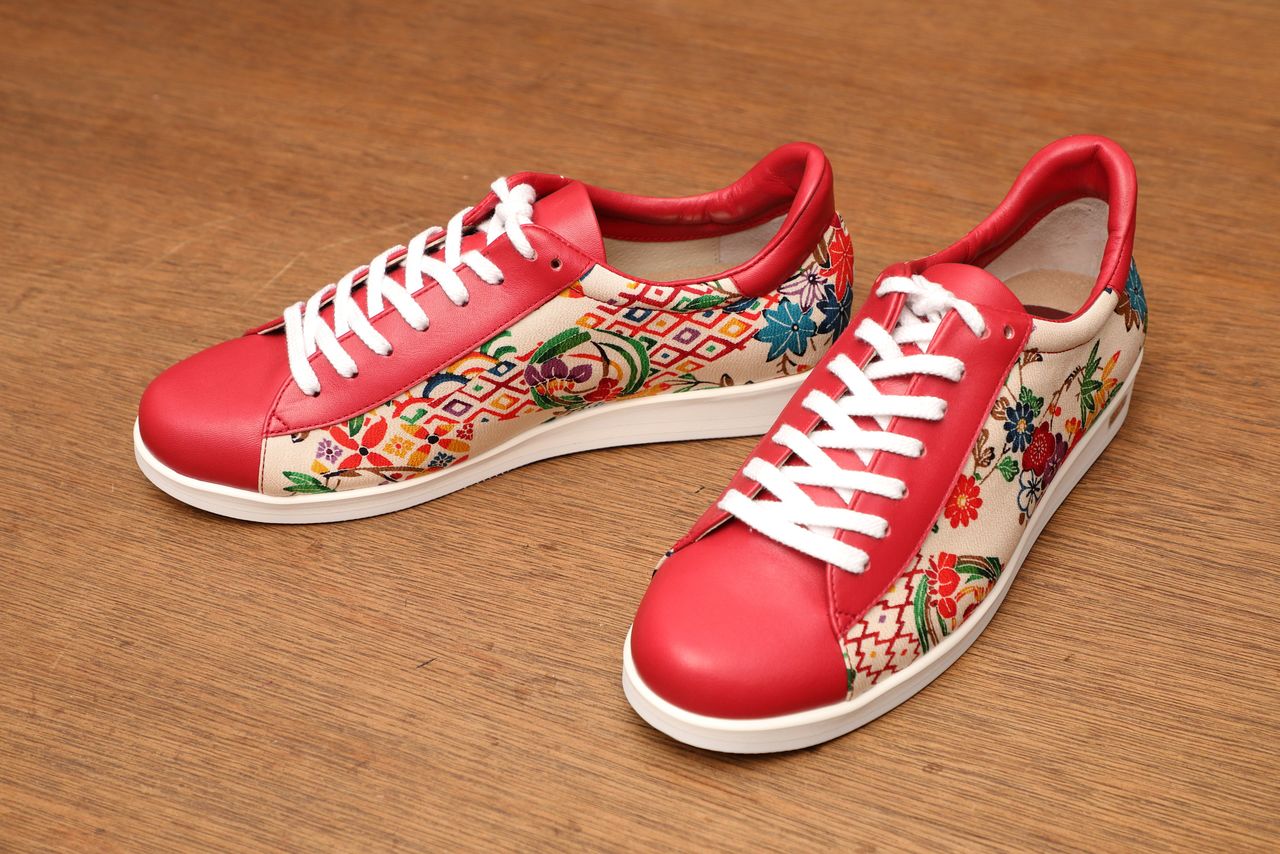
The high-quality texture of the cowhide is perfectly matched with the bright, colorful kimono patterns of these unisex sneakers. (© Hanai Tomoko)
Saving Kimono from the Garbage Heap
Kimono, which use brilliant dyes and fine patterns that depict the beauty of nature, are the traditional dress of Japan. The elegant silk garments are attractive to many non-Japanese people for their traditional Japanese aesthetic sense and for the craftsmanship that brings that sense to life.
Traditionally, kimono were passed on from mother to daughter so that the younger women could wear them on occasions such as coming-of-age day or their wedding. But the difficulty involved in putting on and taking off a kimono and the tedious upkeep they require have led to fewer and fewer people wearing the garment. Due to the fact that kimono are associated with important events and memories and the fact that they cost several hundred thousand yen to purchase, though, many people find it impossible to part with their kimono. They put them away in drawers where they may stay untouched for years. It is estimated that there are around 800 million kimono throughout Japan, representing a value of ¥30 trillion. Many of these are eventually discarded without ever being worn again.
There are companies that purchase second-hand kimono. However, Kawamura explains: “Only about 10 percent of these are returned to the market. The rest are simply discarded.“ Potato Co. takes on kimono that are donated by the owners at no charge. The firm also welcomes those who come directly to the shop to donate their old kimono. Following its August 2023 introduction of a system for refashioning the robes into new items, the company is looking forward to an increase in the number of Japanese customers who place custom orders for shoes that incorporate kimono that they cannot part with completely.

Shoes that feature the fine embroidered designs of obi (kimono sash) are higher priced than those that utilize kimono fabric. (© Hanai Tomoko)
Tokyo Kimono Shoes has also been covered by overseas media. One example is a story on the CNN program “Eco Solutions“ that focused on the company’s efforts to reduce the number of kimono that are discarded.
“Our original goal was to educate the public about Japan’s exceptional craftsmanship,“ explains Kawamura. “But we ended up utilizing a recycled product.“ By collaborating with a highly skilled leather workshop in Asakusa, forming a partnership to craft and sell recycled kimono sneakers, the company combined helping to solve an important social issue—reducing waste—with promoting Japanese craftsmanship worldwide.
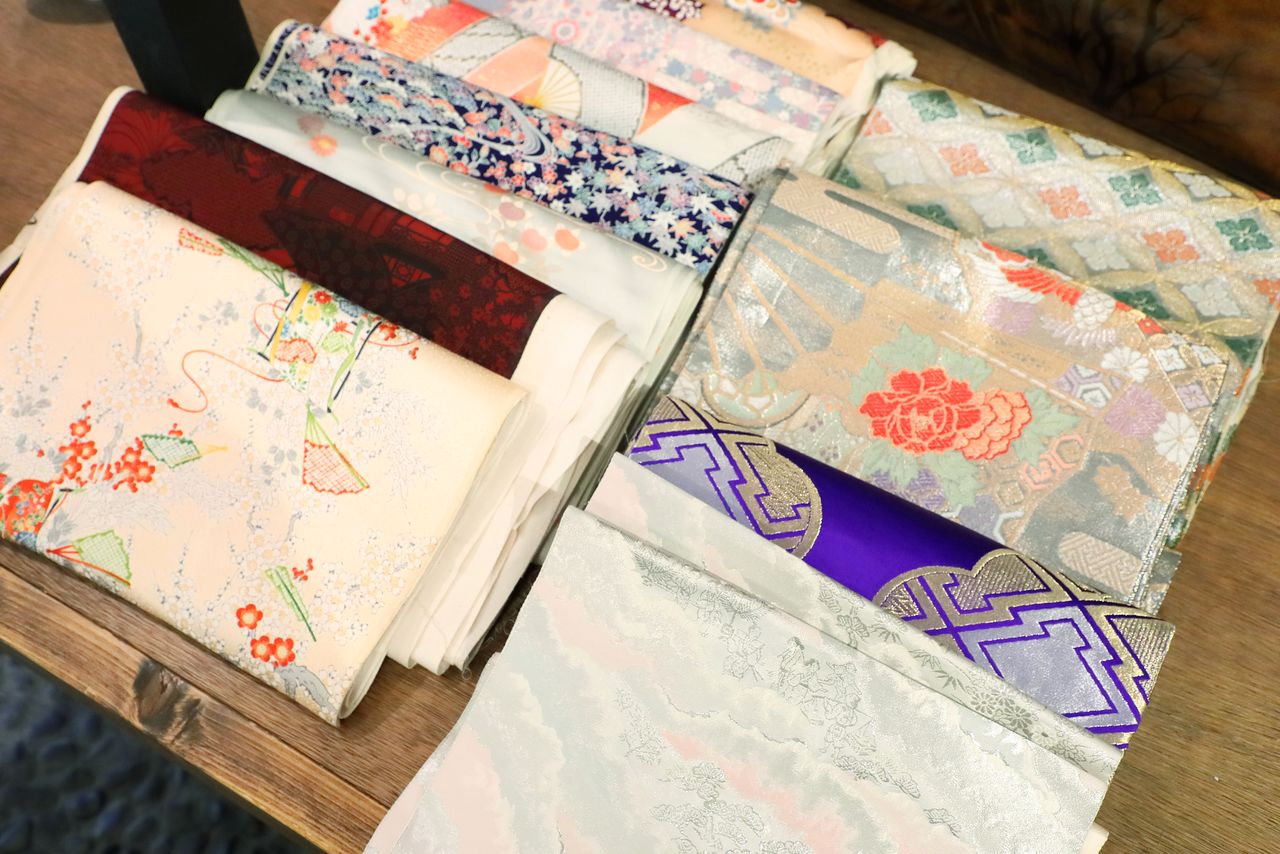
Rescued kimono are used to decorate shoes. (© Hanai Tomoko)
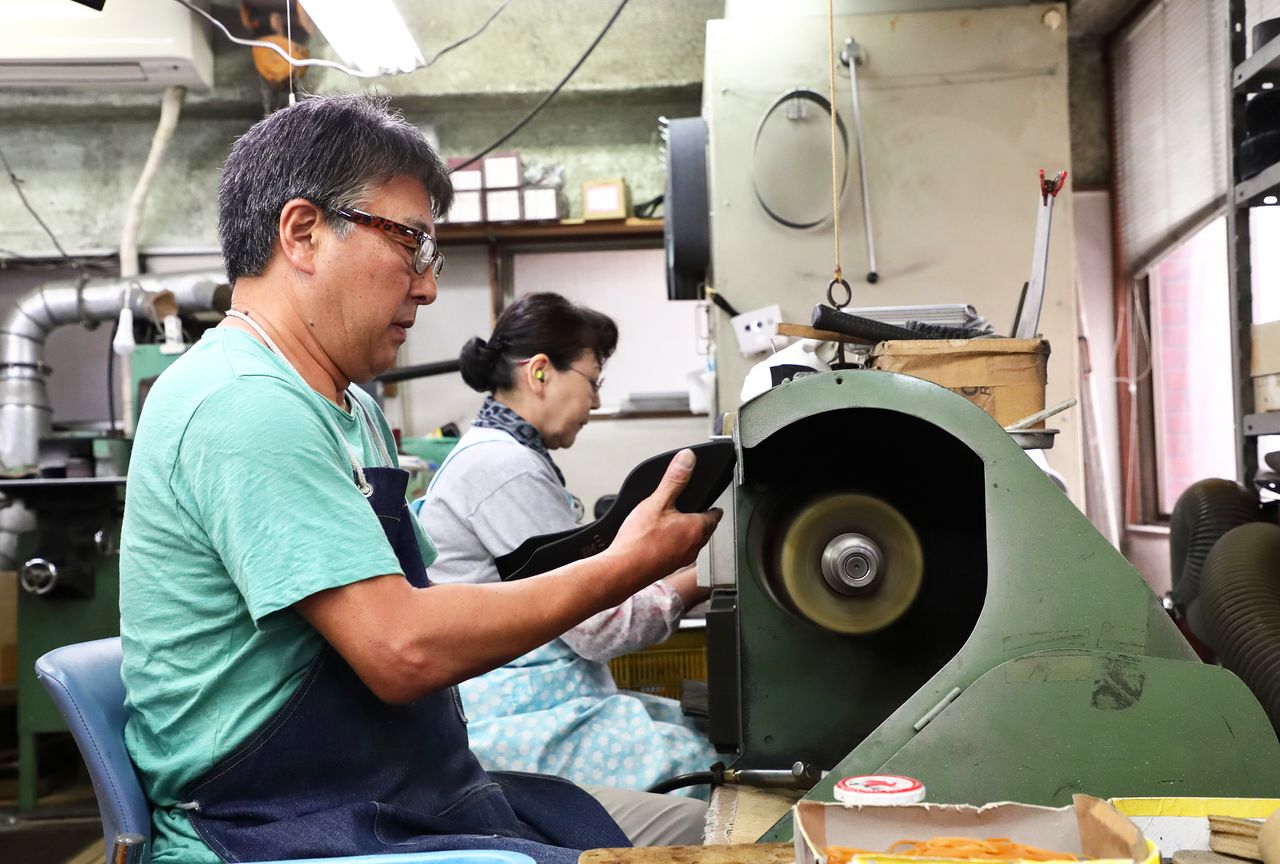
Artisans at the Asakusa workshop have been making shoes since its founding in 1951. (© Hanai Tomoko)
Axt Inc., the leather goods manufacturer that handles production of the sneakers, is within a short walking distance from the shop in Asakusa. The world-renowned tourist spot is home to numerous small shoe and leather goods makers, and its streets are lined with workshops and wholesalers. Founded more than seven decades ago, Axt focuses on small-scale production of a wide variety of items aimed at women.
The Value of “Made in Asakusa“
Tokyo Kimono Shoes takes advantage of the expertise cultivated over many years by artisans. The shoes are crafted with pure silk cloth and leather, and the kimono patterns are carefully selected to match the cowhide. The materials are die cut with importance placed on how well they match the patterns on both sides of the shoes.
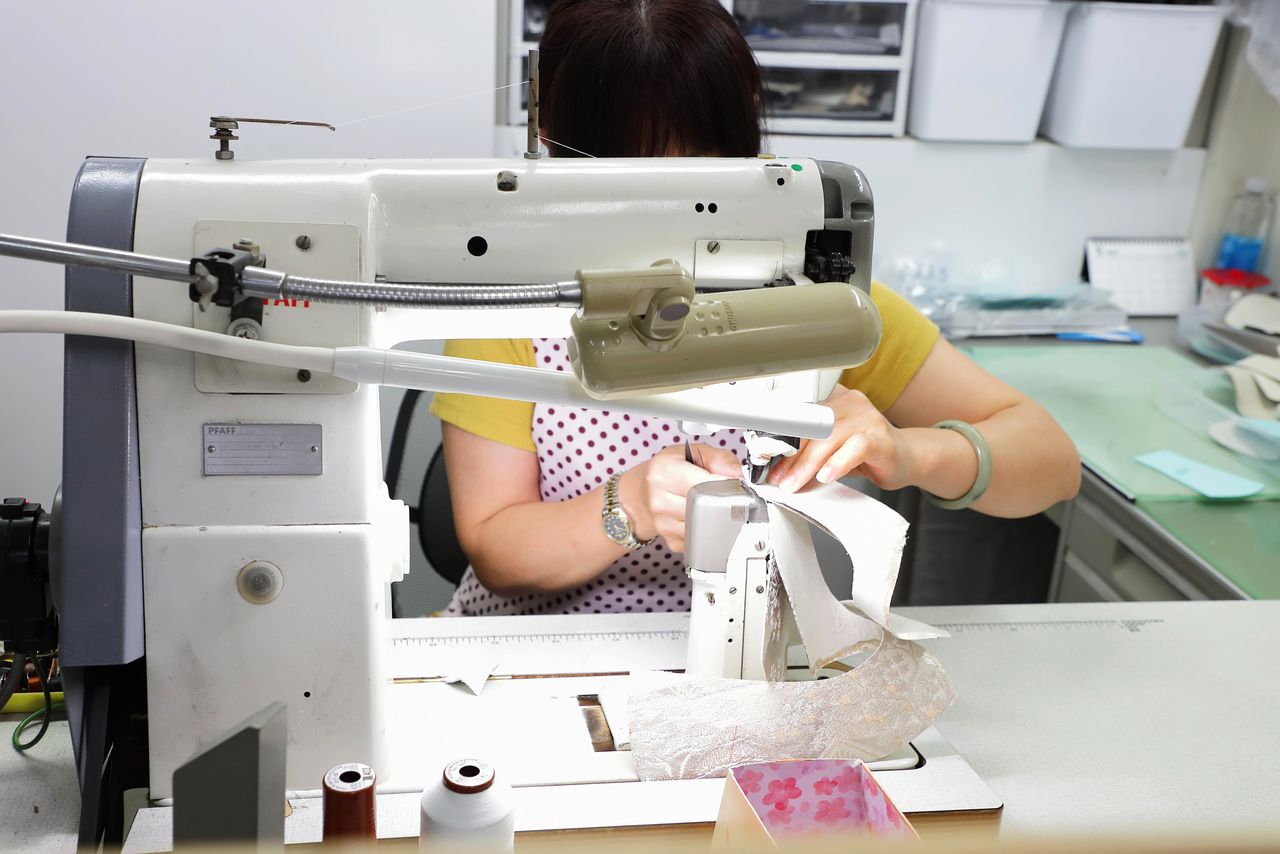
An artisan sewing kimono fabric onto genuine leather. (© Hanai Tomoko)
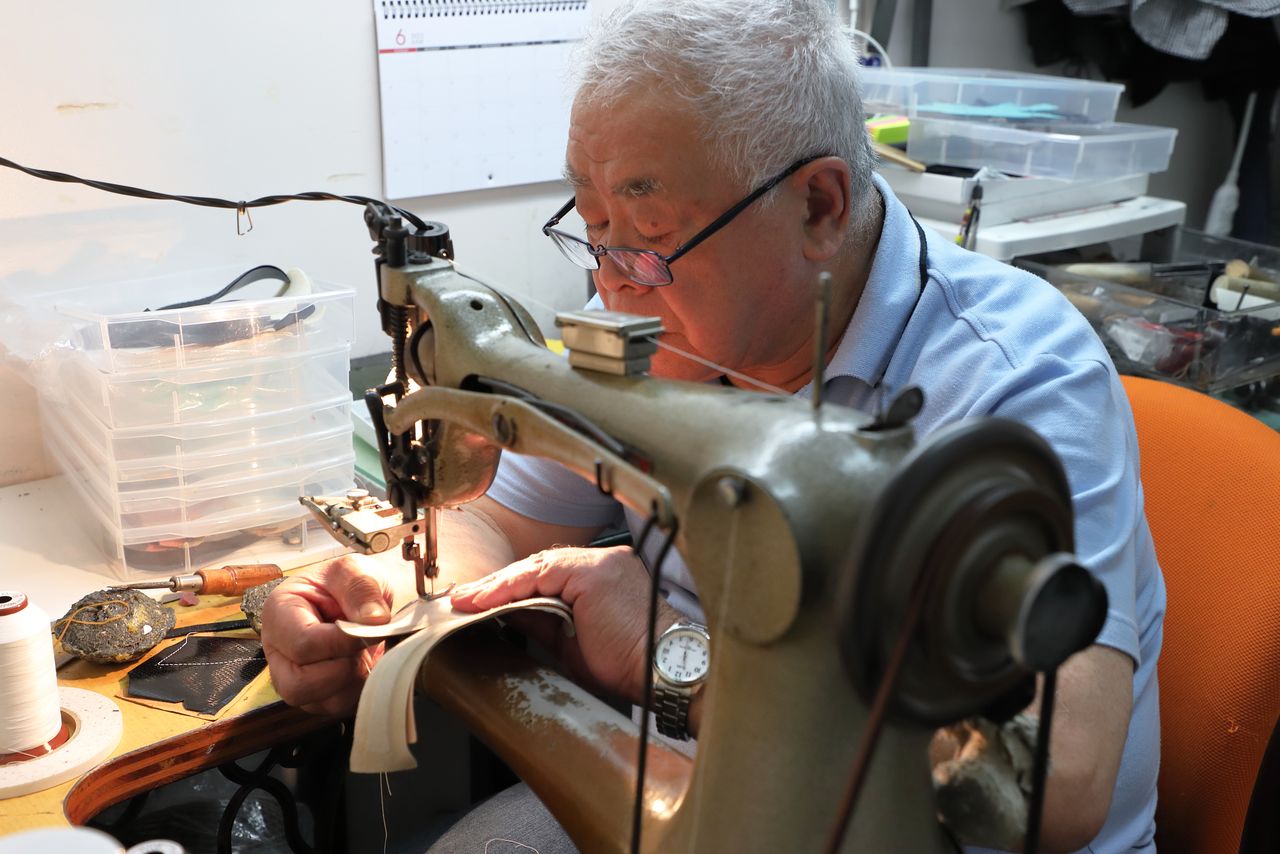
Some of the veteran artisans still use foot-operated treadle sewing machines. (© Hanai Tomoko)
While it is the beautiful kimono pattern designs that initially catch the eye, functional elements ensure that the shoes are comfortable and a pleasure to walk in, too. The pure silk used on the outer surface of the shoes is attached to highly durable cowhide. The fitted insoles of the shoes are made of pigskin, which is resistant to friction and highly breathable. A thin strip of metal known as a shank is inserted into the arch to provide a more stable gait. Shanks, which are commonly used in women’s pumps, are just one example of how Axt incorporates its experience as a manufacturer of women’s shoes into the kimono products.
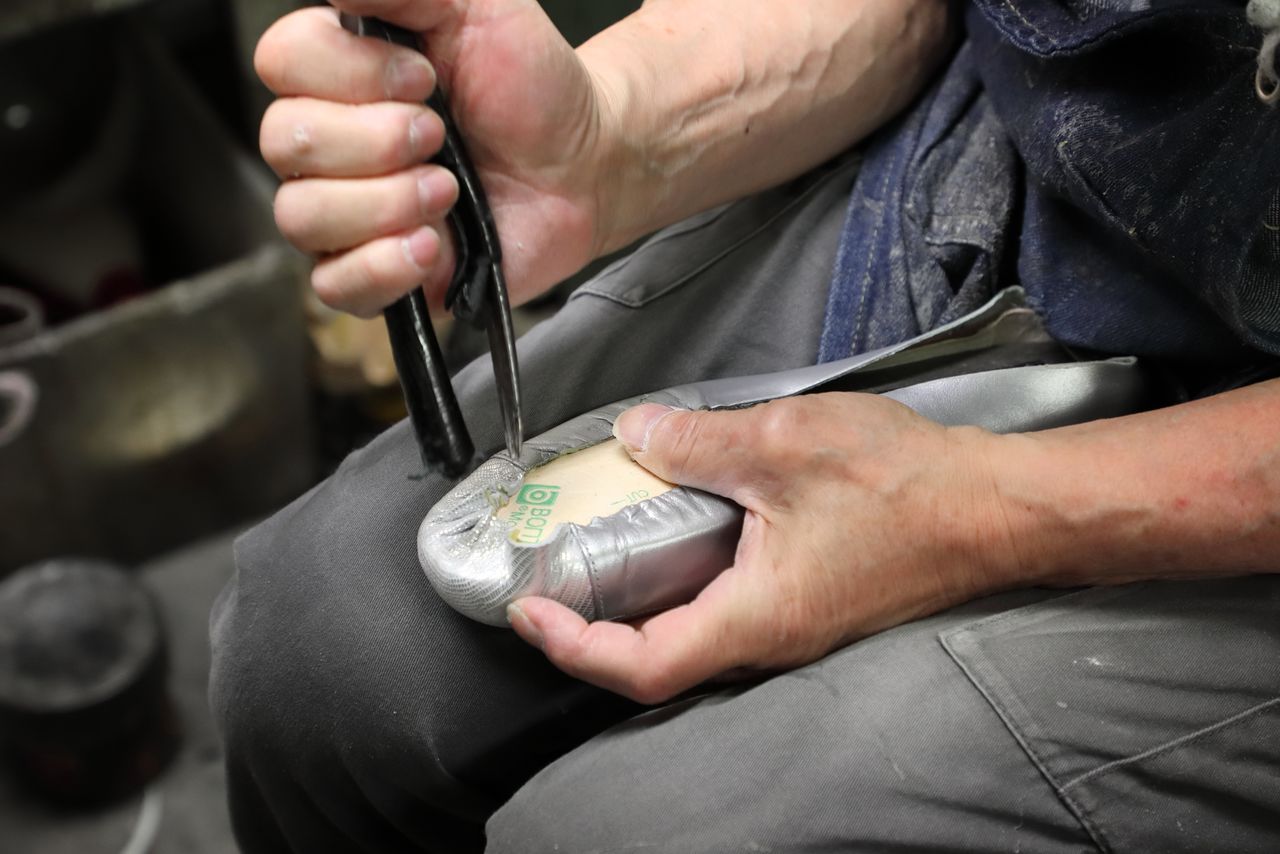
A pull-over technique known as lasting is used to affix the leather uppers to the insoles. All such work is done by hand. (© Hanai Tomoko)

The heel is 25 millimeters high, perfect for effortless walking. (© Hanai Tomoko)
This attention to functionality represents the true value of the “Made in Asakusa“ label. But Kawamura says that it is not advertising slogans that the company emphasizes. What is most important is the customer seeing for him or herself how comfortable the shoes are after purchase.
“Sales are climbing steadily, and more than 10 percent of our customers end up becoming repeat buyers,“ says Kawamura. “This is evidence that they are impressed with the quality of the shoes.“
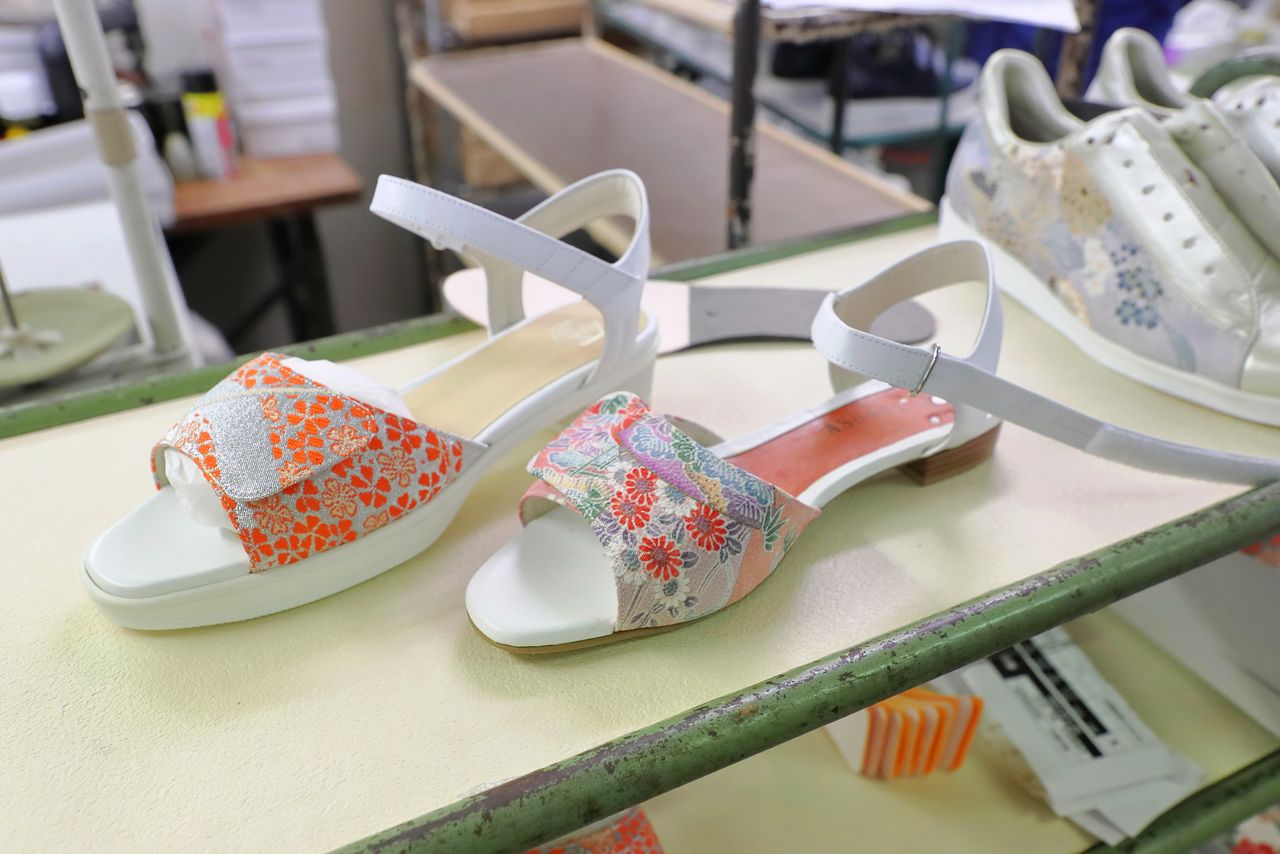
Tokyo Kimono Shoes’ latest offering is kimono sandals. (© Hanai Tomoko)
What initially inspired Kawamura to start this business was an idea he got during his time working in the distribution industry. Spending nine years in India gave him ample opportunity to view Japan from the outside, and one of the things he noticed was that the brand power of “Made in Japan“ was in decline.
“The days of Japanese products dominating the global market had come to an end,“ he observes. “I realized that Japan had been supplanted by countries that were engaged in offshore manufacturing. Household appliances are just one example of Chinese and Korean products taking over as the major sellers. I wanted to tell the world that Japan still had good products that they needed to know about.“
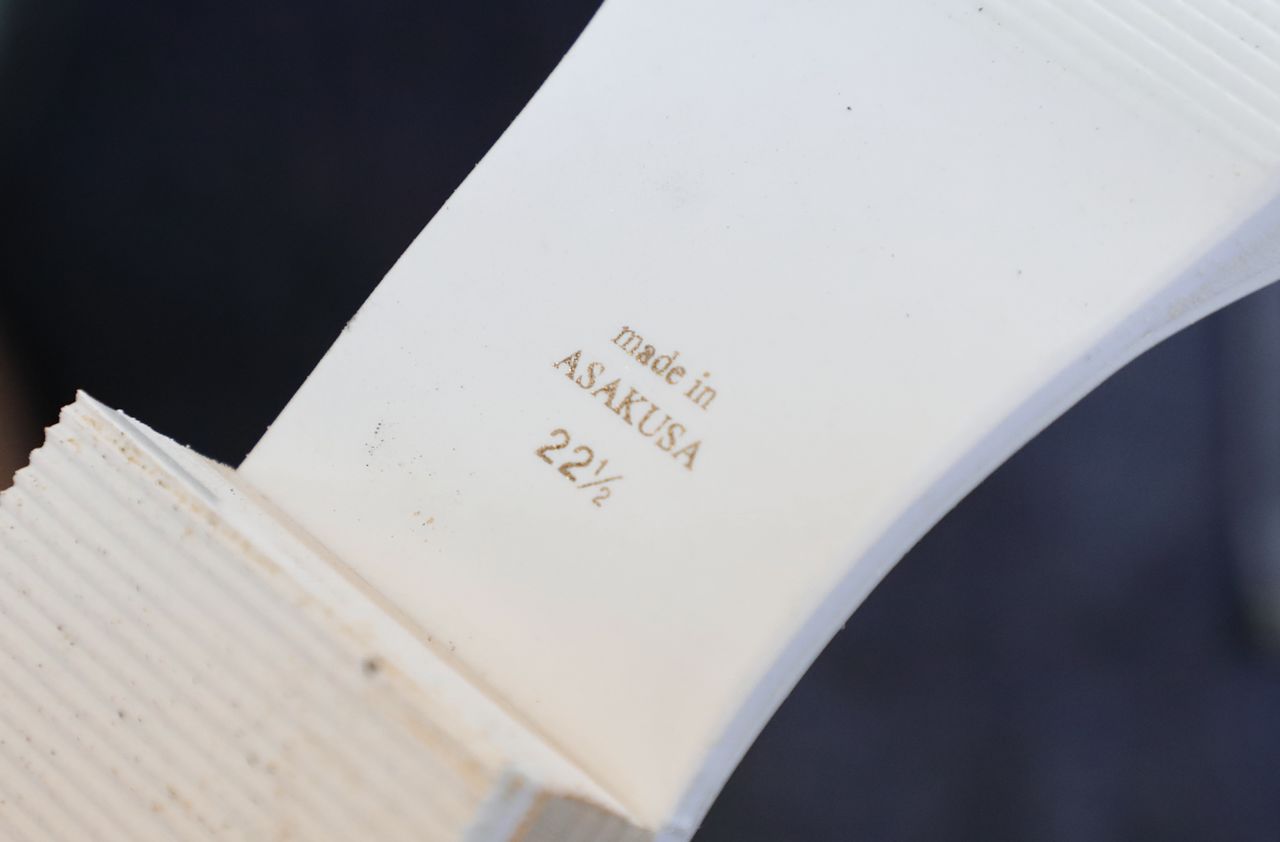
Each shoe is imprinted “Made in Asakusa.“ (© Hanai Tomoko)
Kawamura believed that if he could combine high-quality silk and leather with Japanese craftsmanship, he would achieve a product that would be competitive around the world. Currently, he is developing other products that incorporate recycled kimono material. In the summer of 2023 his company began the manufacture and sale of kimono handbags that feature the tag of a leather goods workshop in Adachi. There are plans to develop belts, wallets, and other similar goods. And Kawamura is also working on an idea to hold seminars on the making of fashion accessories using kimono material as a way to utilize the scraps left over from the shoe manufacturing process.
“I have a lot of ideas that I want to realize,“ says Kawamura. “The problem is that I don’t have a big enough staff to get everything done. The small number of people taking over the shoe and leather goods businesses in Asakusa is a major problem in those industries as well. I hope I can disseminate the true value of the Japan brand throughout the world while at the same time maintain Japanese traditions by finding people who realize the importance of those traditions and what we are doing.“
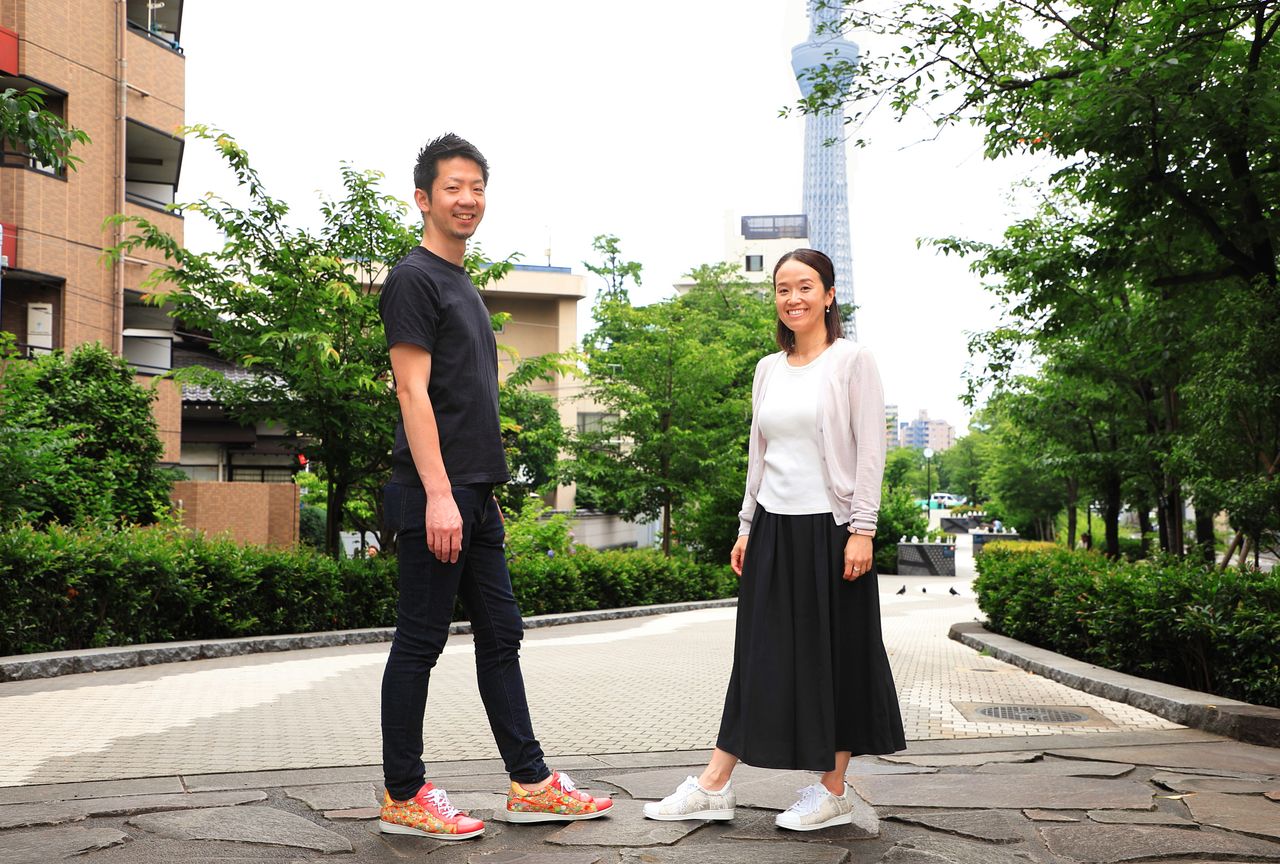
Potato Co. President Kawamura Shōtarō (left) and Konishi Nanami of the company’s PR department sporting kimono shoes. (© Hanai Tomoko)
Tokyo Kimono Shoes Asakusa Shop
- Address: 2-11-9 Hanakawado, Taitō, Tokyo
- Closed on Mondays and Tuesdays
- Hours: 11:00 am to 7:00 pm
- Getting there: 6- to 7-minute walk from Asakusa Station on the Tōbu Railway and Tokyo Metro Ginza Line
- Website: https://tokyokimonoshoes.com
(Originally published in Japanese. Reporting and text by Nippon.com. Photo by Hanai Tomoko.)